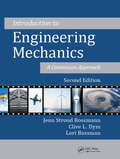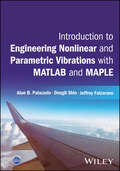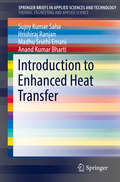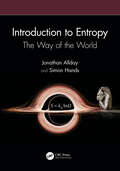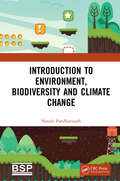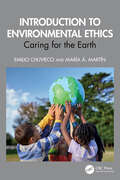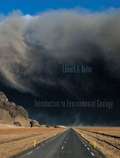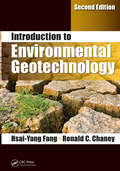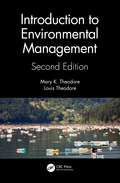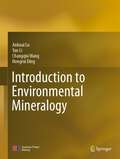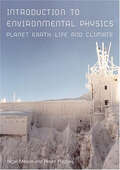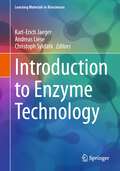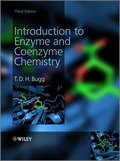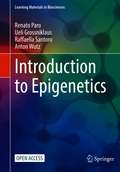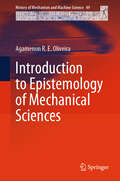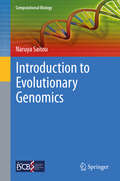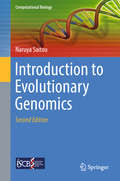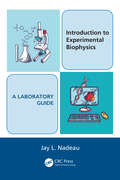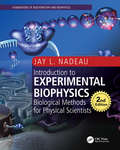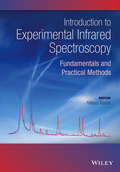- Table View
- List View
Introduction to Engineering Mechanics: A Continuum Approach, Second Edition
by Clive L. Dym Jenn Stroud Rossmann Lori BassmanIntegrated Mechanics Knowledge Essential for Any EngineerIntroduction to Engineering Mechanics: A Continuum Approach, Second Edition uses continuum mechanics to showcase the connections between engineering structure and design and between solids and fluids and helps readers learn how to predict the effects of forces, stresses, and strains. T
Introduction to Engineering Nonlinear and Parametric Vibrations with MATLAB and Maple
by Alan B. Palazzolo Dongil Shin Jeffrey FalzaranoTextbook on nonlinear and parametric vibrations discussing relevant terminology and analytical and computational tools for analysis, design, and troubleshooting Introduction to Engineering Nonlinear and Parametric Vibrations with MATLAB and MAPLE is a comprehensive textbook that provides theoretical breadth and depth and analytical and computational tools needed to analyze, design, and troubleshoot related engineering problems. The text begins by introducing and providing the required math and computer skills for understanding and simulating nonlinear vibration problems. This section also includes a thorough treatment of parametric vibrations. Many illustrative examples, including software examples, are included throughout the text. A companion website includes the MATLAB and MAPLE codes for examples in the textbook, and a theoretical development for a homoclinic path to chaos. Introduction to Engineering Nonlinear and Parametric Vibrations with MATLAB and MAPLE provides information on: Natural frequencies and limit cycles of nonlinear autonomous systems, covering the multiple time scale, Krylov-Bogellubov, harmonic balance, and Lindstedt-Poincare methodsCo-existing fixed point equilibrium states of nonlinear systems, covering location, type, and stability, domains of attraction, and phase plane plottingParametric and autoparametric vibration including Floquet, Mathieu and Hill theoryNumerical methods including shooting, time domain collocation, arc length continuation, and Poincare plottingChaotic motion of nonlinear systems, covering iterated maps, period doubling and homoclinic paths to chaos, and discrete and continuous time Lyapunov exponents Extensive MATLAB and MAPLE coding for the examples presented Introduction to Engineering Nonlinear and Parametric Vibrations with MATLAB and MAPLE is an essential up-to-date textbook on the subject for upper level undergraduate and graduate engineering students as well as practicing vibration engineers. Knowledge of differential equations and basic programming skills are requisites for reading.
Introduction to Enhanced Heat Transfer (SpringerBriefs in Applied Sciences and Technology)
by Sujoy Kumar Saha Hrishiraj Ranjan Madhu Sruthi Emani Anand Kumar BhartiThis Brief stands as a primer for heat transfer fundamentals in heat transfer enhancement devices, the definition of heat transfer area, passive and active enhancement techniques and their potential and benefits and commercial applications. It further examines techniques and modes of heat transfer like single-phase flow and two-phase flow, natural and forced convection, radiation heat transfer and convective mass transfer.
Introduction to Entropy: The Way of the World
by Jonathan Allday Simon HandsThe concept of entropy arises in diverse branches of science, including physics, where it plays a crucial role. However, the nature of entropy as a unifying concept is not widely discussed—it is dealt with in a piecemeal manner within different contexts. The interpretation of the concept is also subtly different in each case. This book will draw these diverse threads together and present entropy as one of the crucial physical concepts. It will cover a range of different applications of entropy, from the classical theory of thermodynamics, the statistical approach, entropy in quantum theory, information theory and finally, its manifestation in black hole physics. Each will be presented in a manner suitable for undergraduates and interested laypersons with no previous knowledge. The book will take an overview of these areas and see to what extent the concept of entropy is being treated in the same way in each, and how it differs.Key Features: Provides an accessible introduction to the exciting topic of entropy, setting out its manifestations in classical thermodynamics, statistical mechanics, and information theory Covers applications in black holes, quantum theory, and Big Bang cosmology
Introduction to Environment, Biodiversity and Climate Change
by Navale PandharinathEnvironment includes air, water, land and the inter relationship between air water, land and human beings and other living creatures, plants micro-organisms and property. Environment effects the wellbeing of man, animal and plants world over. Man is more advanced in intellect and hence it is the duty of man to protect the environment from undesired pollutions. The book discusses various aspects of Global warming, climate change, health hazards, dwindling of forest, water resources and natural resources and stress on biological diversity.Note: T&F does not sell or distribute the Hardback in India, Pakistan, Nepal, Bhutan, Bangladesh and Sri Lanka.
Introduction to Environmental Data Analysis and Modeling (Lecture Notes in Networks and Systems #58)
by Esther Titilayo Akinlabi Moses Eterigho EmetereThis book introduces numerical methods for processing datasets which may be of any form, illustrating adequately computational resolution of environmental alongside the use of open source libraries. This book solves the challenges of misrepresentation of datasets that are relevant directly or indirectly to the research. It illustrates new ways of screening datasets or images for maximum utilization. The adoption of various numerical methods in dataset treatment would certainly create a new scientific approach. The book enlightens researchers on how to analyse measurements to ensure 100% utilization. It introduces new ways of data treatment that are based on a sound mathematical and computational approach.
Introduction to Environmental Engineering
by Stefan Fränzle Bernd Markert Simone WünschmannBuilding on the first principles of environmental chemistry, engineering, and ecology, this volume fills the need for an advanced textbook introducing the modern, integrated environmental management approach, with a view towards long-term sustainability and within the framework of international regulations. As such, it presents the classic technologies alongside innovative ones that are just now coming into widespread use, such as photochemical technologies and carbon dioxide sequestration. Numerous case studies from the fields of air, water and soil engineering describe real-life solutions to problems in pollution prevention and remediation, as an aid to practicing professional skills. With its tabulated data, comprehensive list of further reading, and a glossary of terms, this book doubles as a reference for environmental engineers and consultants.
Introduction to Environmental Ethics: Caring for the Earth
by Emilio Chuvieco Maria A. MartinA comprehensive introductory textbook that integrates environmental ethics with social and religious perspectives, this cross-disciplinary approach helps students understand the depth and breadth of environmental issues in a globally relevant way. Environmental problems are explained by ecological, social, ethical, and religious dimensions that inspire environmental conservation. It underlines the reasons why intrinsic values of nature, and those who inhabit it, must be taken into consideration when making decisions that affect them. This book is also intended for those interested in understanding the environmental debate which is a critical component of environmental management.Features Presents the historical review of the environmental movement. Introduces ethical reasoning in environmental problems. Explains environmental ethic approaches and practical implications. Discusses the role of religions in nature conservation and Eco-theology. Includes exercises for reflection in each chapter to stimulate student engagement with environmental issues. This great textbook gives readers new insight into caring for the environment. It is for undergraduate and graduate students taking courses in environmental studies, geography, sociology, anthropology, and philosophy, as well as professionals in environmental management and environmental policy, and for those interested in environmental issues and the ethics of nature conservation.
Introduction to Environmental Geology Fifth Edition
by Edward A. KellerThis text focuses on helping non-science majors develop an understanding of how geology and humanity interact. Ed Keller--the author who first defined the environmental geology curriculum--focuses on five fundamental concepts of environmental geology: Human Population Growth, Sustainability, Earth as a System, Hazardous Earth Processes, and Scientific Knowledge and Values. These concepts are introduced at the outset of the text, integrated throughout the text, and revisited at the end of each chapter. The Fifth Edition emphasizes currency, which is essential to this dynamic subject, and strengthens Keller's hallmark "Fundamental Concepts of Environmental Geology," unifying the text's diverse topics while applying the concepts to real-world examples.
Introduction to Environmental Geotechnology
by Hsai-Yang Fang Ronald C. ChaneyThis new edition of a bestseller presents updated technology advances that have occurred since publication of the first edition. It increases the utility and scope of the content through numerous case studies and examples and an entirely new set of problems and solutions. The book also has an accompanying instructor's guide and presents rubrics by which instructors can increase student learning and evaluate student outcomes, chapter by chapter. The book focuses on the increasing importance of water resources and energy in the broader context of environmental sustainability. It’s interdisciplinary coverage includes soil science, physical chemistry, mineralogy, geology, ground pollution, and more.
Introduction to Environmental Management
by Louis Theodore Mary K. TheodoreWritten at a level that is accessible to students in all disciplines, Introduction to Environmental Management, Second Edition translates complex environmental issues into practical and understandable terms. The book provides students and practitioners an understanding of the regulations, pollutants, and waste management issues that can be applied in various related environmental fields and industries. This new edition is updated throughout and adds eleven new chapters, including coverage of water conservation, water toxins, measurement methods, desalination, industrial ecology, legal issues, and more. Features: Updated throughout and includes eleven all-new chapters Reviews the specialized literature on pollution prevention, sustainability, and the role of optimization in water treatment and related areas, as well as references for further reading Provides illustrative examples and case studies that complement the text throughout Includes ancillary exams and a solutions manual for adopting instructors This book serves as a complete teaching tool, offering a combination of insightful coverage, concise language, and convenient pedagogical features, and supplies practical guidance that will aid students and practitioners alike.
Introduction to Environmental Mineralogy
by Yan Li Anhuai Lu Changqiu Wang Hongrui DingThis book focuses on the environmental property of minerals including mineralogical record of environmental changes, mineralogical influence on the environmental quality, mineralogical evaluation of the environment, mineralogical processing of environmental pollutants and interaction between minerals and microbes. Understanding of the environmental property of minerals is a good supplement to the traditional concept of “mineral”. By demonstrating plenty of case studies with easy-to-understand figures and tables, this book introduces the environmental effects of interaction between minerals and microbes, physiological and ecological effects of biomineralization, reductive precipitation property of iron sulfide minerals, photocatalytic reduction property of sphalerite, photocatalytic oxidation property of rutile, tubular structure property of chrysotile, tunnel structure property of K-feldspar tetrahedron, tunnel structure property of cryptomelane octahedron, nano property of cryptomelane, crystallization property of jarosite, interaction between semiconducting minerals and microbes, pathological mineralization of human body, mineralogical processing of inorganic pollutants, mineralogical degradation of organic pollutants, mineralogical purification of smoke-type pollutants, mineralogical evaluation of soil environmental quality, mineralogical prevention and control of waste pollutants and mineralogical processing of mine tailings. The book is written for environmental mineralogist as well as postgraduates majoring in environmental science.
Introduction to Environmental Physics: Planet Earth, Life and Climate
by Peter Hughes N.J. MasonThe changing climate and its affect on all of us is becoming increasingly apparent - ozone depletion, hurricanes, floods and extreme weather behaviour. Introduction to Environmental Physics challenges the way we think about how and why environmental change occurs.This authoritative book aims to cover some of the more common and popular topics a
Introduction to Environmental Toxicology
by J P D'MelloIntroduction to Environmental Toxicology is designed as a concise text, introducing students to the fundamentals of this important subject. It covers the origin, characterization and environmental distribution of the major pollutants, and provides an explanation of their implications for human morbidity via the development of cancer, cardiovascular disease, pulmonary dysfunction and neurological conditions. Considering impacts on biodiversity, such as effects from acid rain, heavy metals and selected anthropogenic compounds, this book: - Covers biogenic contaminants, gases and particulates, organic pollutants, petroleum, heavy metals, complex polymers and radiation; - Considers the impact of pollutants across human health, biodiversity, water and food safety; - Includes questions, further reading and case studies to spark discussion in tutorials. Covering all the major biological toxins and pollutants, this book forms a true introduction to the subject for undergraduates studying environmental toxicology and related subjects.
Introduction to Environmental Toxicology: Molecular Substructures to Ecological Landscapes, Fifth Edition
by Wayne Landis Ruth Sofield Ming-Ho YuThe fifth edition includes new sections on the use of adverse outcome pathways, how climate change changes how we think about toxicology, and a new chapter on contaminants of emerging concern. Additional information is provided on the derivation of exposure-response curves to describe toxicity and they are compared to the use of hypothesis testing. The text is unified around the theme of describing the entire cause-effect pathway from the importance of chemical structure in determining exposure and interaction with receptors to the use of complex systems and hierarchical patch dynamic theory to describe effects to landscapes.
Introduction to Enzyme Technology (Learning Materials in Biosciences)
by Andreas Liese Karl-Erich Jaeger Christoph SyldatkThis interdisciplinary textbook provides an easy-to-understand and highly topical introduction to all the specialist areas of modern enzyme technology.In the first part of this three-part textbook, the reader is introduced to the fundamentals of enzyme structure, reaction mechanisms, enzyme kinetics, enzyme modeling, and process control. In the second part, methods for finding, expressing, optimizing, purifying, immobilizing, and using enzymes in unusual reaction media are presented. In the third part, leading experts use examples to describe current applications of enzymes in the chemical and pharmaceutical industries, for biomass degradation, food production and processing, as additives in detergents and cleaning agents, for constructing biosensors, and as therapeutics.Students of bachelor and master programs in biology, chemistry, biochemistry, and bioprocess engineering will gain up-to-date access to practical applications and developing industries. However, the fluent writing style makes the work suitable for all readers, who want to gain an easy-to-understand insight into the production and application of enzymes.This book is a translation of an original German edition. The translation was done with the help of artificial intelligence (machine translation by the service DeepL.com). A subsequent human revision was done primarily in terms of content, so that the book will read stylistically differently from a conventional translation.
Introduction to Enzyme and Coenzyme Chemistry
by T. D. BuggEnzymes are giant macromolecules which catalyse biochemical reactions. They are remarkable in many ways. Their three-dimensional structures are highly complex, yet they are formed by spontaneous folding of a linear polypeptide chain. Their catalytic properties are far more impressive than synthetic catalysts which operate under more extreme conditions. Each enzyme catalyses a single chemical reaction on a particular chemical substrate with very high enantioselectivity and enantiospecificity at rates which approach "catalytic perfection". Living cells are capable of carrying out a huge repertoire of enzyme-catalysed chemical reactions, some of which have little or no precedent in organic chemistry.The popular textbook Introduction to Enzyme and Coenzyme Chemistry has been thoroughly updated to include information on the most recent advances in our understanding of enzyme action, with additional recent examples from the literature used to illustrate key points. A major new feature is the inclusion of two-colour figures, and the addition of over 40 new figures of the active sites of enzymes discussed in the text, in order to illustrate the interplay between enzyme structure and function.This new edition provides a concise but comprehensive account from the perspective of organic chemistry, what enzymes are, how they work, and how they catalyse many of the major classes of enzymatic reactions, and will continue to prove invaluable to both undergraduate and postgraduate students of organic, bio-organic and medicinal chemistry, chemical biology, biochemistry and biotechnology.
Introduction to Epigenetics (Learning Materials in Biosciences)
by Renato Paro Ueli Grossniklaus Raffaella Santoro Anton WutzThis open access textbook leads the reader from basic concepts of chromatin structure and function and RNA mechanisms to the understanding of epigenetics, imprinting, regeneration and reprogramming. The textbook treats epigenetic phenomena in animals, as well as plants. Written by four internationally known experts and senior lecturers in this field, it provides a valuable tool for Master- and PhD- students who need to comprehend the principles of epigenetics, or wish to gain a deeper knowledge in this field. After reading this book, the student will:Have an understanding of the basic toolbox of epigenetic regulationKnow how genetic and epigenetic information layers are interconnectedBe able to explain complex epigenetic phenomena by understanding the structures and principles of the underlying molecular mechanismsUnderstand how misregulated epigenetic mechanisms can lead to disease
Introduction to Epistemology of Mechanical Sciences (History of Mechanism and Machine Science #49)
by Agamenon R. OliveiraThis book investigates the development of mechanical sciences with a focus on epistemological issues. It examines the precursors and fundamental milestones of Newton's theory of motion, a geometry of motion since Greek antiquity, the influences of Robert Hooke on Newton's studies on the orbital motion of the planets, and finally, the orbital motion model with a central force inversely proportional to the square of the distance to this centre. By looking at the development of mechanics throughout history, especially with a careful look at epistemological issues, the book highlights the multiple relationships that the mechanical sciences build with other sciences, the economy, and the popular culture.
Introduction to Evolutionary Genomics
by Naruya SaitouThis book is the first of its kind to explain the fundamentals of evolutionary genomics. The comprehensive coverage includes concise descriptions of a variety of genome organizations, a thorough discussion of the methods used, and a detailed review of genome sequence processing procedures. The opening chapters also provide the necessary basics for readers unfamiliar with evolutionary studies. Features: introduces the basics of molecular biology, DNA replication, mutation, phylogeny, neutral evolution, and natural selection; presents a brief evolutionary history of life from the primordial seas to the emergence of humans; describes the genomes of prokaryotes, eukaryotes, vertebrates, and humans; reviews methods for genome sequencing, phenotype data collection, homology searches and analysis, and phylogenetic tree and network building; discusses databases of genome sequences and related information, evolutionary distances, and population genomics; provides supplementary material at an associated website.
Introduction to Evolutionary Genomics (Computational Biology #Vol. 17)
by Naruya SaitouThis authoritative textbook/reference presents a comprehensive introduction to the field of evolutionary genomics. The opening chapters describe the fundamental concepts in molecular biology and genome evolution for readers without any prior background in this area. This is followed by a detailed examination of genome evolution in various different groups of organisms. The text then concludes with a review of practical methods essential to researchers in the field.This updated and revised new edition also features historical perspectives on contributions to evolutionary genomics from related fields such as molecular evolution, genetics, and numerical taxonomy.Topics and features: introduces the basics of molecular biology, covering protein structure and diversity, as well as DNA replication, transcription, and translation; examines the phylogenetic relationships of DNA sequences, and the processes of mutation, neutral evolution, and natural selection; presents a brief evolutionary history of life, surveying the key features of the genomes of prokaryotes, eukaryotes, viruses and phages, vertebrates, and humans; reviews the various biological “omic” databases, and discusses the analysis of homologous nucleotide and amino acid sequences; provides an overview of the experimental sequencing of genomes and transcriptomes, and the construction of phylogenetic trees; describes methods for estimating of evolutionary distances, and performing studies of population genetics; supplies additional supporting material at an associated website.Serving as an indispensable textbook for graduate and advanced undergraduate courses on evolutionary genomics, this accessible overview will also prove invaluable to researchers from both computer science and the biological sciences seeking a primer on the field.
Introduction to Experimental Biophysics - A Laboratory Guide
by Jay L. NadeauEasily Get Started with Biological ExperimentsIntroduction to Experimental Biophysics - A Laboratory Guide presents wet lab methods for courses in biophysics or molecular biology. A companion to the author's highly praised An Introduction to Experimental Biophysics: Biological Methods for Physical Scientists, this manual offers a flexible course pl
Introduction to Experimental Biophysics: Biological Methods for Physical Scientists (Second Edition) (Foundations of Biochemistry and Biophysics)
by Jay L. Nadeau<p>This fully updated and expanded text is the best starting point for any student or researcher in the physical sciences to gain firm grounding in the techniques employed in molecular biophysics and quantitative biology. It includes brand new chapters on gene expression techniques, advanced techniques in biological light microscopy (super-resolution, two-photon, and fluorescence lifetime imaging), holography, and gold nanoparticles used in medicine. <p>The author shares invaluable practical tips and insider’s knowledge to simplify potentially confusing techniques. The reader is guided through easy-to-follow examples carried out from start to finish with practical tips and insider’s knowledge. The emphasis is on building comfort with getting hands "wet" with basic methods and finally understanding when and how to apply or adapt them to address different questions. </p>
Introduction to Experimental Infrared Spectroscopy
by Mitsuo TasumiInfrared spectroscopy is generally understood to mean the science of spectra relating to infrared radiation, namely electromagnetic waves, in the wavelength region occurring intermediately between visible light and microwaves. Measurements of infrared spectra have been providing useful information, for a variety of scientific research and industrial studies, for over half a century; this is set to continue in the foreseeable future.Introduction to Experimental Infrared Spectroscopy is intended to be a handy guide for those who have no, or limited, experience in infrared spectroscopic measurements but are utilising infrared-related methods for their research or in practical applications.Written by leading researchers and experienced practitioners, this work consists of 22 chapters and presents the basic theory, methodology and practical measurement methods, including ATR, photoacoustic, IR imaging, NIR, 2D-COS, and VCD. The six Appendices will aid readers in understanding the concepts presented in the main text.Written in an easy-to-understand way this book is suitable for students, researchers and technicians working with infrared spectroscopy and related methods.
Introduction to Experimental Methods
by Terry W. ArmstrongIntroduction to Experimental Methods succinctly explains fundamental engineering concepts in mechanics, dynamics, heat transfer, and fluid dynamics. From conceptualizing an engineering experiment to conducting a comprehensive lab, this book enables students to work through the entire experimental design process.Offering a complete overview of instruction for engineering lab methodology, the book includes practical lab manuals for student use, directly complementing the instruction. Numerous worked examples and problems are presented along with several hands-on experiments in individual lab manuals. This book discusses how to write lab reports, how to configure a variety of instruments and equipment, and how to work through failures in experimentation.Introduction to Experimental Methods is intended for senior undergraduate engineering students taking courses in Experimental Methods. Instructors will be able to utilize a Solutions Manual for their course.Features: Provides an overview of experimental methods in mechanics, dynamics, heat transfer, and fluid dynamics Covers design of experiments, instruments, and statistics Discusses SolidWorks and PASCO Capstone software Includes numerous end-of-chapter problems and worked problems Features a Solutions Manual for instructor use
